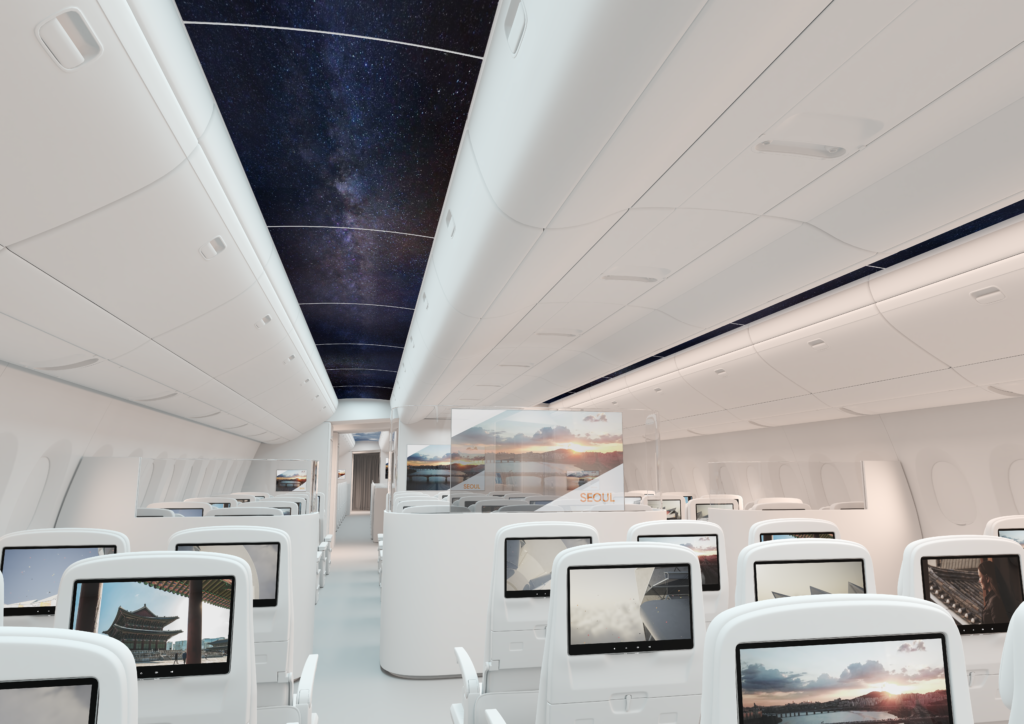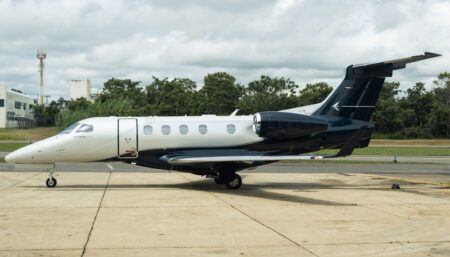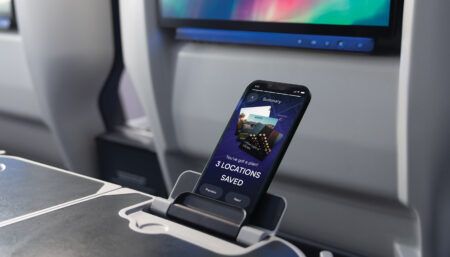From transparent OLED screens to voltage and weight advances in cabin power, the business jet interiors market could benefit from IFE/CMS innovations arising in commercial aviation, finds Marisa Garcia
As evident from displays at Aircraft Interiors Expo (AIX) this year, commercial aviation is exploring new IFE/CMS hardware and technology to enhance passenger satisfaction. While mainly focused on a commercial application, the potential crossover of some of these developments to VIP and business jet interiors is food for thought.
Modern air travellers demand more than just a seat and a view. Power solutions, HD screens and user friendly cabin control technologies have become essential components of the passenger journey.
Forged through a partnership between aviation expert Lufthansa Technik and consumer sector giant LG Electronics, Aerq facilitates consumer electronic trends at altitude, specifically in display technologies.
Though primarily targeting commercial aviation, Verena Bintaro, head of marketing and public relations, Aerq, shares some possible applications in the private jet space. “Aerena cabin digital signage could suit private aviation needs,” she notes. “Lightweight, flexible and slim OLED displays could display personalised or ambient content to create a unique atmosphere. As customisation of private aircraft is highly desirable, digital content that can be customised easily would enhance the cabin experience in a new way.”
The company’s digital concepts include bulkhead displays, signage and ceiling panels. “Part of Aerena cabin digital signage, the virtual ceiling can set the atmosphere in the cabin, making the passenger’s experience personal and unique,” says Bintaro.
Aerq also showed a Transparent Class Divider at AIX 2023. “It divides large cabin environments in a visually appealing manner and can be used as a display,” says Bintaro. “It allows the display of content while seeing through the screen to check the status in the adjacent cabin class.”
Bintaro sees opportunities for private jet cabin designers to create a digitally dynamic cabin environment. “Display size and, in this case, shape, is a good example for the difference between commercial and private jets as there is more flexibility in the location of monitors in a private aircraft,” she says.
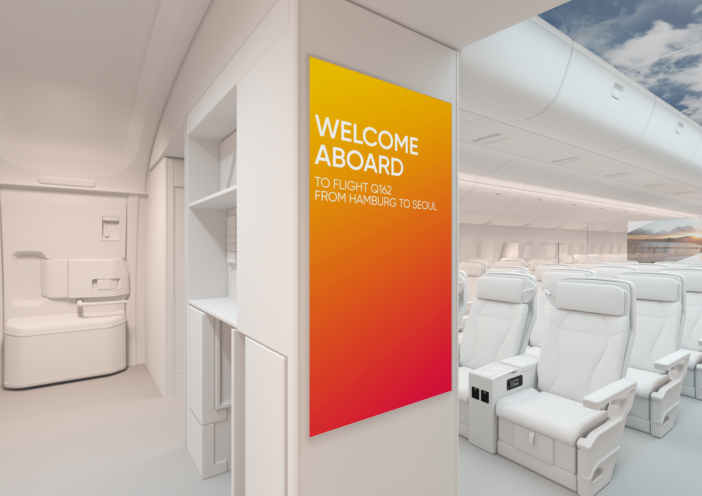
Commercial versus private
“Both sectors drive innovation equally, though perhaps from different points of view and with other considerations,” Bintaro continues. “IFEC has evolved from systems added to the cabin as an afterthought into a product embedded into the industrial design. This evolution brings new technologies such as OLED, curved or transparent displays with various sizes to fulfil individual needs in commercial and private aviation cabins. The commercial cabin has high occupancy and utilisation. Materials must be durable. The hardware on board, like monitors, is less embedded to allow easy installation, removal and replacement. There is more flexibility in monitor location in private aircraft.”
Another solution displayed at AIX by Aerq is the Aerena cloud-based software platform, which allows airlines to update IFE content rapidly. This technology is transferable to the private jet space, where customisation and flexibility are paramount.
“The biggest trends currently are application-based software, connectivity, data processing, hygiene and PED integration,” says Bintaro. “Those trends overlap between commercial cabins and business jets. Application-based software must be highly customisable and tailored to an airline’s business model and objectives. The Aerq-created Aerena cloud-based, modular IT platform enables airlines to create a distinctive digital cabin experience. Updating media content, customising the UI and managing applications fast and flexibly is desired for commercial or private aircraft.”
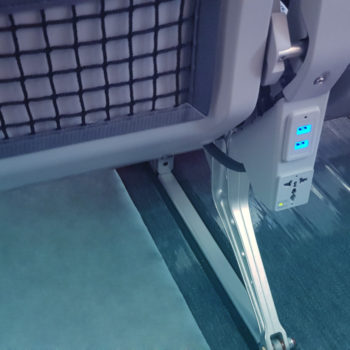
Power play
In both sectors, cabin power supply is a priority to support passengers’ use of PEDs. One specialist in this area, working across both sectors, is Astronics. Its most recent power development is the EmPower UltraLite G2 in-seat power system, which uses a distributed zonal architecture, leveraging 800W power supplies to provide up to 60W of power at every seat with a combination of USB-A and the latest USB-C outlets.
Astronics says the system offers a 30-40% weight reduction over some other power solutions, and is suitable for retrofit or linefit. It has commitments from more than a dozen airlines to install the system on more than 1,100 narrow-body aircraft. The company’s other solutions include wireless chargers that can be installed unobtrusively underneath veneer.
Another provider is Burrana, which says its Rise Power in-seat power solution can be installed on any commercial or business jet aircraft type. Rise Power has a 48VDC common power backbone and is designed to be 20% lighter than traditional AC architectures.
Burrana says its solution offers advantages including that its USB-A power outlet offers 15W of power versus 10W, for faster charging, and that enhanced load shed management and intelligent power sharing distribute power evenly, rather than on a ‘first come, first served’ basis. There is also a solution to upgrade existing 10/15W systems to 60W USB-C with an outlet swap.
Asked to compare the airline and private jet marketplace, David Pook, VP of customer experience at Burrana, says: “Both are on a never-ending quest to enhance the passenger experience through technology and innovation. It all comes down to budgets to fund such developments. It’s an obvious conclusion that commercial aviation drives innovation on cost and weight, while business aviation may be more innovative in technology for special applications and compatibility with consumer devices. In both sectors, there are great examples of pioneering innovation that set new benchmarks and early adopters of consumer electronics who seek to replicate similar experiences in the cabin.”
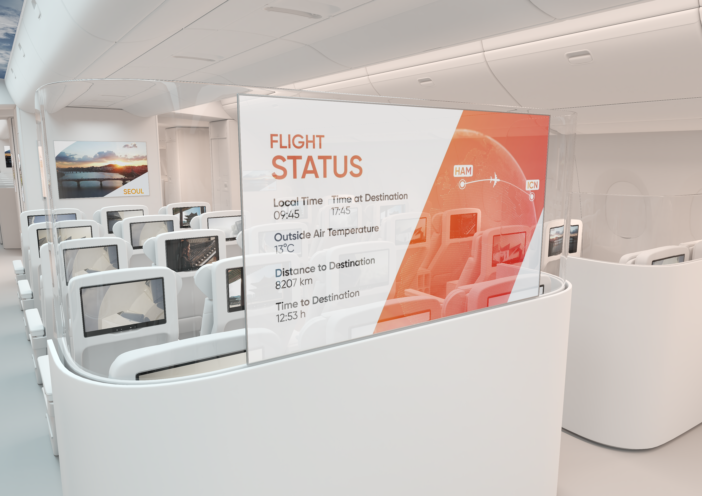
QLED and OLED
He predicts that certain consumer electronics advances will impact both sectors: “QLED and OLED technologies have proven weight and cost benefits as well as longer life for commercial airlines, so we expect such developments will become normalised in business aviation.”
“Also, as we have witnessed in commercial aviation, there are potential use cases for business jets to use personal devices as a ‘companion’ device in synch with the onboard network,” Pook continues. “When it comes to IFE, there are such different license agreements for content (film, TV, audio) due to performance and broadcasting rights. There is much greater freedom of access to the business jet market, such as accessing individual subscriptions for streamed content, which is the holy grail for commercial airlines!”
The interplay of commercial and private aviation should ensure both benefit from each other’s innovations, ultimately enhancing the cabin experience.
This feature was written by Marisa Garcia and first published in the September/October 2023 edition of Business Jet Interiors International.


